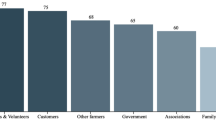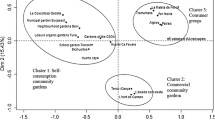Abstract
Farm to institution (FTI) programs represent alternative supply chains that aim to organize the activities of local producers with institutions that feed the local community. The current study demonstrates the value of structuration theory (Giddens in J Theory Soc Behav 13(1):75–80, 1983; The constitution of society: outline of the theory of structuration. University of California Press, Berkeley, 1984) for conceptualizing how FTI agents create, maintain, and change organizational structures associated with FTI and traditional supply chains. Based on interviews with supply chain agents participating in FTI programs, we found that infrastructure, relationships, and pricing were seen as important factors that enabled and constrained FTI organizing. Additionally, we describe how FTI organizing serves to simultaneously reinforce and challenge the practices associated with traditional supply chains. Theoretical and practical implications are discussed as well as directions for future research.
Similar content being viewed by others
Abbreviations
- FTI:
-
Farm to institution
- FSD:
-
Food service director
References
Allen, P., and J. Guthman. 2006. From “old school” to “farm-to-school”: Neoliberalization from the ground up. Agriculture and Human Values 23(4): 401–415.
Bloom, J.D., and C.C. Hinrichs. 2011. Moving local food through conventional food system infrastructure: Value chain framework comparisons and insights. Renewable Agriculture and Food Systems 26(1): 13–23.
Braun, V., and V. Clarke. 2006. Using thematic analysis in psychology. Qualitative Research in Psychology 3(2): 77–101.
Buckley, J., D.S. Conner, C. Matts, and M.W. Hamm. 2013. Social relationships and farm-to-institution initiatives: Complexity and scale in local food systems. Journal of Hunger & Environmental Nutrition 8(4): 397–412.
Carmack, H.J. 2010. Structuring and disciplining apology: A structural analysis of health care benevolence laws. Qualitative Research Reports in Communication 11(1): 6–13.
Charmaz, K. 2006. Constructing grounded theory: A practical guide through qualitative inquiry. Thousand Oaks, CA: Sage.
Conner, D.S., B.T. Izumi, T. Liquori, and M.W. Hamm. 2012a. Sustainable school food procurement in large K-12 districts: Prospect for value chain partnerships. Agricultural and Resource Economics Review 41(1): 100–113.
Conner, D.S., B. King, C. Koliba, J.M. Kolodinsky, and A. Trubek. 2011a. Mapping farm-to-school networks: Implications for research and practice. Journal of Hunger and Environmental Nutrition 6: 133–152.
Conner, D.S., B. King, J.M. Kolodinsky, E. Roche, C. Koliba, and A. Trubek. 2012b. You can know your school and feed it too: Vermont farmers’ motivations and distribution practices in direct sales to school food services. Agriculture and Human Values 29(3): 321–332.
Conner, D.S., A. Nowak, J. Berkenkamp, G.W. Feenstra, J. Van Soelen Kim, T. Liquori, and M. Hamm. 2011b. Value chains for sustainable procurement in large school districts: Fostering partnerships. Journal of Agriculture, Food Systems, and Community Development 1(4): 55–68.
Conner, D.S., N. Sevoian, S.N. Heiss, and L. Berlin. 2014. The diverse values and motivations of Vermont farm to institution supply chain actors. Journal of Agricultural and Environmental Ethics. doi:10.1007/s10806-013-9485-4.
Day-Fansworth, L., B. McCown, M. Miller, and A. Rfeiffer. 2009. Scaling up: Meeting the demand for local food. Madison, WI: UW-Extension Ag Innovation Center and UW-Madison Center for Integrated Agricultural Systems. http://www.cias.wisc.edu/scaling-up-meeting-the-demand-for-local-food/. Accessed 5 March 2014.
Falat, S. M. 2011. Scaling up ‘buy local, sell fresh’: Lessons from Michigan growers, suppliers, and Sysco. Unpublished Master’s Thesis. East Lansing, MI: Michigan State University.
Fischer, M., M. Hamm, R. Pirog, J. Fisk, J. Farbman, and S. Kiraly. 2013. Findings of the 2013 National Food Hub Survey. Michigan State University Center for Regional Food Systems and The Wallace Center at Winrock International. http://foodsystems.msu.edu/activities/food-hub-survey. Accessed 5 March 2014.
George, V. 2011. Scaling up and preserving local food values: A value chain analysis of local food procurement in a metropolitan public school system. Unpublished Master’s Thesis. East Lansing, MI: Michigan State University.
Giddens, A. 1983. Comments on the theory of structuration. Journal for the Theory of Social Behaviour 13(1): 75–80.
Giddens, A. 1984. The constitution of society: Outline of the theory of structuration. Berkeley, CA: University of California Press.
Grant, R.M. 1996. Prospering in dynamically-competitive environments: Organizational capability as knowledge integration. Organization Science 7: 375–387.
Hardesty, S.D. 2008. The growing role of local food markets. American Journal of Agricultural Economics 90(5): 1289–1295.
Heyl, B.S. 2002. Ethnographic interviewing. In Handbook of ethnography, ed. P. Atkinson, A. Coffey, S. Delamont, J. Lofland, and L. Lofland, 369–383. Thousand Oaks, CA: Sage.
Izumi, B.T., D.W. Wright, and M.W. Hamm. 2010. Market diversification and social benefits: Motivations of farmers participating in farm to school programs. Journal of Rural Studies 26(4): 374–382.
Kloppenburg, J., D. Wubben, and M. Grunes. 2008. Linking the land and the lunchroom: Lessons from the Wisconsin Homegrown Lunch Project. Journal of Hunger and Environmental Nutrition 3(4): 440–455.
Lai, K. 2009. Linking exchange governance with supplier cooperation and commitment: A case of container terminal operations. Journal of Business Logistics 30(1): 243–263.
La Londe, B.J., and J.M. Masters. 1994. Emerging logistics strategies: Blueprints for the next century. International Journal of Physical Distribution & Logistics Management 24(7): 35–47.
Main, T.J. 1996. Analyzing evidence for the structural theory of homelessness. Journal of Urban Affairs 18: 449–457.
Main, T.J. 1998. How to think about homelessness: Balancing structural and individual causes. Journal of Social Distress and the Homeless 7(1): 41–54.
Marsden, T., J. Banks, and G. Bristo. 2000. Food supply chain approaches: Exploring their role in rural development. Sociologia Ruralis 2(1): 15–22.
New, S.J. 1997. The scope of supply chain management research. Supply Chain Management 2(1): 15–22.
Nickerson, V. 2008. Understanding Vermont’s local food landscape: An inventory and assessment of recent local food initiatives. Prepared for the Vermont Sustainable Agriculture Council. http://nofavt.org/assets/files/pdf/Nickerson%20Final%20SAC%20Report%2012_15_08.pdf. Accessed 5 March 2014.
Nyaga, G.N., J.M. Whipple, and D.F. Lynch. 2010. Examining supply chain relationships: Do buyers and suppliers perspectives on collaborative relationships differ? Journal of Operations Management 28: 101–104.
Patton, M.Q. 2002. Qualitative research & evaluation methods. Thousand Oaks, CA: Sage.
Polkinghorne, D.E. 2005. Language and meaning: Data collection in qualitative research. Journal of Counseling Psychology 52(2): 137–145.
Poole, M.S., and R.D. McPhee. 2005. Structuration theory. In Engaging organizational communication theory and research: Multiple perspectives, ed. S.K. May, and D.K. Mumby, 171–196. Thousand Oaks, CA: Sage.
Prasad, P. 2005. Crafting qualitative research: Working in the post positivist traditions. Armonk, NY: M.E. Sharpe.
Pullman, M.E., and J. Dillard. 2010. Values based supply chain management and emergent organizational structures. International Journal of Operations & Production Management 30(7): 744–771.
Roche, E., D.S. Conner, J.M. Kolodinsky, E. Buckwalter, L. Berlin, and A. Powers. 2012. Social cognitive theory as a framework for considering farm to school programming. Childhood Obesity 8(4): 357–363.
Sarkis, J., Z. Qinghua, and L. Kee-hung. 2010. An organizational theoretical review of green supply chain management literature. Working paper No. 2010-11. George Perkins Marsh Institute, Clark University. http://scarlet.clarku.edu/departments/marsh/news/WP2010-11.pdf. Accessed 5 March 2014.
Schafft, K., C.C. Hinrich, and J.D. Bloom. 2010. Pennsylvania farm-to-school programs and the articulation of local context. Journal of Hunger and Environmental Nutrition 5(1): 23–40.
Seale, W., A. Berry, and J. Cullen. 2004. Disembedding the supply chain: Institutionalized reflexivity and inter-firm accounting. Accounting, Organizations and Society 29(1): 73–92.
Yates, J. 1997. Using Giddens’ structuration theory to inform business history. Business and Economic History 26(1): 159–183.
Author information
Authors and Affiliations
Corresponding author
Rights and permissions
About this article
Cite this article
Heiss, S.N., Sevoian, N.K., Conner, D.S. et al. Farm to institution programs: organizing practices that enable and constrain Vermont’s alternative food supply chains. Agric Hum Values 32, 87–97 (2015). https://doi.org/10.1007/s10460-014-9527-1
Accepted:
Published:
Issue Date:
DOI: https://doi.org/10.1007/s10460-014-9527-1




